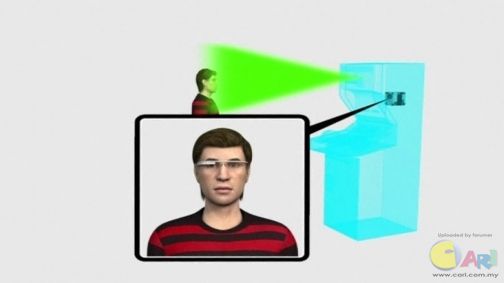|
WASHINGTON DC, April 23 — A recently surfaced patent filing that lists Microsoft founder Bill Gates as one of its investors proposes a method for alerting people to unwanted snooping on their devices. The animation above is based on the patent application and explains how such a system would work. Gates is one of 16 co-investors in the Unauthorized Viewer Detection System and Method, which the patent filing describes a “system for detecting and responding to an intruding camera.” The United States patent application, which was filed on December 11, 2012, outlines a way to equip devices such as ATMs and smartphones with a technology that would scan for and respond to unwanted viewers or cameras by alerting the user or obscuring the contents on the screen. However, the patent filing does not describe a particular technology, nor is there any word on when such as system would be available. The patent filing explains that the system would work as follows: Intruder analysis module scans the input for viewers, and classifies them as either intruders or safe viewers. Intruder analysis module also scans the input for cameras or camera-equipped devices (e.g., SLR cameras, camera-equipped cellular phones, point-and-shoot cameras, building-mounted camera systems, etc.). Intruder analysis module may classify an object as a viewer or camera using any number of detection algorithms. For example, intruder analysis module may apply motion detection algorithms on the sensor information, and may classify any moving object as a viewer. As another example, intruder analysis module may apply shape detection algorithms that scans the sensor information for lens (e.g., circular) shapes. As another example, intruder analysis module may apply shape detection algorithms that scans the sensor information to determine whether a detected camera has a lens cap emplaced; in this case it may not be considered as an intruder. As another example, intruder analysis module may apply shape detection algorithms that scans the sensor information to determine the orientation of a detected camera … .  For example, the processing circuit may blur the contents of the display or cause an alert to appear, thereby notifying user of the intrusion. In this manner, sensitive content can be protected from being captured by unauthorised cameras. It should be understood that the application is not limited to detecting cameras attached to buildings, and that other scenarios are envisioned. For example, electronic media display device 1300 may detect another cellular phone equipped with a camera. Similar embodiments are also useful in public locations or while a user is taking public transportation, where intruding cameras are likely to be present. — Reuters Check out the VIDEO here. MMail
|
ADVERTISEMENT